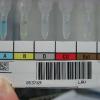Reputation Activity
-
 Dansket reacted to SMILLER in Billing - Second ABO/RH for Resolving Discrepancy
Dansket reacted to SMILLER in Billing - Second ABO/RH for Resolving Discrepancy
I don't think so. It's not like charging for a antibody ID after getting a positive screen. It would be more like repeating a charge for, say, a potassium because the analyzer failed on running it the first time. So I would say no, you cannot bill again.
Scott
-
 Dansket got a reaction from jtrick in 2nd blood bank specimen for ABO/RH confirmation
Dansket got a reaction from jtrick in 2nd blood bank specimen for ABO/RH confirmation
Does the blood bank armband have a unique identifying number/letter code? If so, require that the person collecting the 2nd sample write the blood bank armband number/letter code on the specimen container label. Then match the code in the blood bank upon receipt of the 2nd sample.
-
 Dansket reacted to SMILLER in Immediate spin crossmatch
Dansket reacted to SMILLER in Immediate spin crossmatch
If I understand the question, I think that you could say that any negative reverse reaction on the patient's ABO typing would serve as a negative control--however, this would not be good enough for O patients. For a positive control, you would likewise be stuck on AB patients. But I do not think that patient specimens are regulated as "QC-able" materials in the case of a IS XM.
Regardless, I would think that the "pos/neg" QC regulations are concerned with validating reagent reactivity and system integrity, and not so much with one patient's specimen reacting with another's RBCS.
Scott
-
 Dansket got a reaction from gagpinks in Immediate spin crossmatch
Dansket got a reaction from gagpinks in Immediate spin crossmatch
Could the Daily/Day of Use QC for the ABO Plasma Grouping Cells ( A1 and B ) be considered a positive and negative control for the saline crossmatch? In both cases these tests use patient serum/plasma added to donor red cells, the only difference being that the ABO Plasma Grouping cells are stored in solution designed to maintain agglutinability while the donor cells are stored in a solution designed to maintain oxygen transport.
-
 Dansket got a reaction from David Saikin in Massive Transfusion and Incompatible Plasma
Dansket got a reaction from David Saikin in Massive Transfusion and Incompatible Plasma
There was a prominent trauma surgeon who said, "Patients die from the blood they don't get, not the blood they do get".
-
 Dansket got a reaction from applejw in Massive Transfusion and Incompatible Plasma
Dansket got a reaction from applejw in Massive Transfusion and Incompatible Plasma
There was a prominent trauma surgeon who said, "Patients die from the blood they don't get, not the blood they do get".
-
 Dansket got a reaction from John C. Staley in Massive Transfusion and Incompatible Plasma
Dansket got a reaction from John C. Staley in Massive Transfusion and Incompatible Plasma
There was a prominent trauma surgeon who said, "Patients die from the blood they don't get, not the blood they do get".
-
 Dansket got a reaction from jayinsat in Massive Transfusion and Incompatible Plasma
Dansket got a reaction from jayinsat in Massive Transfusion and Incompatible Plasma
There was a prominent trauma surgeon who said, "Patients die from the blood they don't get, not the blood they do get".
-
 Dansket got a reaction from AMcCord in cord blood weak D testing with positive IgG
Dansket got a reaction from AMcCord in cord blood weak D testing with positive IgG
We report the newborn to be Rh Indeterminate, with a comment that the newborn is treated as if Rh Positive for purposes of determining the mother's RhIg candidacy. Additionally, the newborn may be tested in 4-6 months to determine the baby's true Rh type.
-
 Dansket got a reaction from Ensis01 in Transfusion Reaction Workup
Dansket got a reaction from Ensis01 in Transfusion Reaction Workup
Nursing is required to call Blood Bank and also to order Request to Investigate Suspected Adverse Reaction to Blood Transfusion in their computer. The computer request is sent to Meditech (Lab and BB computer) to order Transfusion Reaction Investigation. Blood sample is collected ( and blood container with Transfusion form) and routed to BB for DAT and Visual Inspection. Clerical Check is done comparing information on blood container label, transfusion form and pretransfusion blood sample for any discrepancies. This process is documented as the STAT Investigation. An EXTENDED Investigation (repeat Type and Screen, Crossmatch, chemistries, etc.) is done only if clerical discrepancies, serological discrepancies or Visual Inspection are noted.
-
 Dansket got a reaction from TreeMoss in IFU Anti-D
Dansket got a reaction from TreeMoss in IFU Anti-D
Healthcare Facility Accreditation Program (HFAP). They serve a similar function as JCAHO in the United States.
I mentioned this issue to Malcolm and others in another thread regarding this same issue as to how facilities can justify interpreting the presence of agglutination in the Anti-D test ( with a negative Anti-D control test) as Rh Negative!
Both ORTHO and BioRad state in their direction inserts for Anti-D that agglutination is a positive test result and must be interpreted as Rh Positive. If the academic data is so compelling, why haven't the antisera manufacturers changed their directions for interpreting Anti-D test results? Why haven't the accrediting agencies changed their inspection criteria?
The academic and accrediting communities are not in synch! Which has priority in the United States?
-
 Dansket got a reaction from Ensis01 in IFU Anti-D
Dansket got a reaction from Ensis01 in IFU Anti-D
The discrepancies found (typically Type and Screen requests) are not necessarily newborns but are usually adults who were reported to be Rh Negative or Rh Positive (years ago) who currently test differently. We will request a second independent venipuncture, test that blood sample accordingly to resolve the discrepancy, and report the results with comments as appropriate.
-
 Dansket got a reaction from Ensis01 in IFU Anti-D
Dansket got a reaction from Ensis01 in IFU Anti-D
If the newborn rbcs are agglutinated in the Weak D test and are unagglutinated in the Weak D Control test, our computer interprets and reports these test results as Rh Positive.
-
 Dansket got a reaction from Malcolm Needs in cord blood weak D testing with positive IgG
Dansket got a reaction from Malcolm Needs in cord blood weak D testing with positive IgG
We report the newborn to be Rh Indeterminate, with a comment that the newborn is treated as if Rh Positive for purposes of determining the mother's RhIg candidacy. Additionally, the newborn may be tested in 4-6 months to determine the baby's true Rh type.
-
 Dansket got a reaction from TreeMoss in cord blood weak D testing with positive IgG
Dansket got a reaction from TreeMoss in cord blood weak D testing with positive IgG
We report the newborn to be Rh Indeterminate, with a comment that the newborn is treated as if Rh Positive for purposes of determining the mother's RhIg candidacy. Additionally, the newborn may be tested in 4-6 months to determine the baby's true Rh type.
-
 Dansket got a reaction from tkakin in cord blood weak D testing with positive IgG
Dansket got a reaction from tkakin in cord blood weak D testing with positive IgG
We report the newborn to be Rh Indeterminate, with a comment that the newborn is treated as if Rh Positive for purposes of determining the mother's RhIg candidacy. Additionally, the newborn may be tested in 4-6 months to determine the baby's true Rh type.
-
 Dansket got a reaction from Patty in cord blood weak D testing with positive IgG
Dansket got a reaction from Patty in cord blood weak D testing with positive IgG
We report the newborn to be Rh Indeterminate, with a comment that the newborn is treated as if Rh Positive for purposes of determining the mother's RhIg candidacy. Additionally, the newborn may be tested in 4-6 months to determine the baby's true Rh type.
-
 Dansket got a reaction from John C. Staley in cord blood weak D testing with positive IgG
Dansket got a reaction from John C. Staley in cord blood weak D testing with positive IgG
We report the newborn to be Rh Indeterminate, with a comment that the newborn is treated as if Rh Positive for purposes of determining the mother's RhIg candidacy. Additionally, the newborn may be tested in 4-6 months to determine the baby's true Rh type.
-
 Dansket got a reaction from jalomahe in cord blood weak D testing with positive IgG
Dansket got a reaction from jalomahe in cord blood weak D testing with positive IgG
We report the newborn to be Rh Indeterminate, with a comment that the newborn is treated as if Rh Positive for purposes of determining the mother's RhIg candidacy. Additionally, the newborn may be tested in 4-6 months to determine the baby's true Rh type.
-
 Dansket got a reaction from Ensis01 in IFU Anti-D
Dansket got a reaction from Ensis01 in IFU Anti-D
I believe the FDA is the ultimate authority in the US. CAP, HFAP, Joint Commission and State regulators all act as surrogates for the FDA and are subservient to them.
-
 Dansket got a reaction from Ensis01 in IFU Anti-D
Dansket got a reaction from Ensis01 in IFU Anti-D
Which scientific paper(s) does your SOP cite to support your practice of adding a second drop of anti-D to a negative (no agglutination) Anti-D test?
Which scientific paper(s) does your SOP cite so support your practice of interpreting 1+ agglutination in the Anti-D test as Rh Negative?
HFAP in the Healthcare Facility Accreditation Program that has the same deemed status with CMMS as does Joint Commission.
-
 Dansket got a reaction from John C. Staley in IFU Anti-D
Dansket got a reaction from John C. Staley in IFU Anti-D
Healthcare Facility Accreditation Program (HFAP). They serve a similar function as JCAHO in the United States.
I mentioned this issue to Malcolm and others in another thread regarding this same issue as to how facilities can justify interpreting the presence of agglutination in the Anti-D test ( with a negative Anti-D control test) as Rh Negative!
Both ORTHO and BioRad state in their direction inserts for Anti-D that agglutination is a positive test result and must be interpreted as Rh Positive. If the academic data is so compelling, why haven't the antisera manufacturers changed their directions for interpreting Anti-D test results? Why haven't the accrediting agencies changed their inspection criteria?
The academic and accrediting communities are not in synch! Which has priority in the United States?
-
 Dansket got a reaction from John C. Staley in Coombs Check acceptable reaction
Dansket got a reaction from John C. Staley in Coombs Check acceptable reaction
If the check cells are agglutinated, then antiglobulin reagent was added to the tube, test confirmed. There is no scientific evidence to support grading the reaction or to repeat the test if the strength of agglutination does not meet some arbitrary definition.
-
 Dansket reacted to AuntiS in Coombs Check acceptable reaction
Dansket reacted to AuntiS in Coombs Check acceptable reaction
The reagent we use includes instructions that only specify a positive reaction is required. It does not give a minimum grade.
I remember being taught 2+ many years ago, but we now only require macroscopic agglutination.
sandra
-
 Dansket got a reaction from jalomahe in Antibody Enhancement
Dansket got a reaction from jalomahe in Antibody Enhancement
Your negative antibody screen QC tube (to which AES has bee added) would serve as a negative control. Lack of agglutination in the antibody-screen-negative tube method is an expected result that demonstrates the AES reagent is not causing a false-positive agglutination.








